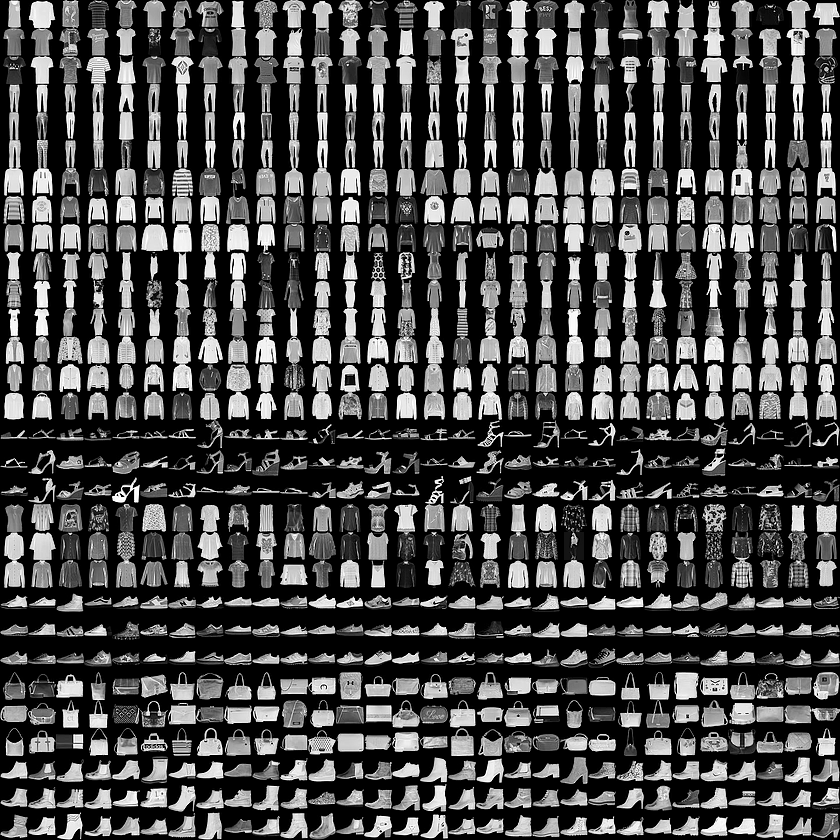https://github.com/fyt3rp4til/fashionmnist
https://github.com/fyt3rp4til/fashionmnist
matplotlib normalization python3 tensorflow
Last synced: 2 months ago
JSON representation
- Host: GitHub
- URL: https://github.com/fyt3rp4til/fashionmnist
- Owner: FYT3RP4TIL
- Created: 2023-09-09T11:37:25.000Z (over 1 year ago)
- Default Branch: main
- Last Pushed: 2023-09-24T15:33:53.000Z (over 1 year ago)
- Last Synced: 2025-01-14T07:13:48.138Z (4 months ago)
- Topics: matplotlib, normalization, python3, tensorflow
- Language: Jupyter Notebook
- Homepage:
- Size: 48.8 KB
- Stars: 0
- Watchers: 1
- Forks: 0
- Open Issues: 0
-
Metadata Files:
- Readme: README.md
Awesome Lists containing this project
README
# Fashion-MNIST
`Fashion-MNIST` is a dataset of [Zalando](https://jobs.zalando.com/tech/)'s article images—consisting of a training set of 60,000 examples and a test set of 10,000 examples. Each example is a 28x28 grayscale image, associated with a label from 10 classes. We intend `Fashion-MNIST` to serve as a direct **drop-in replacement** for the original [MNIST dataset](http://yann.lecun.com/exdb/mnist/) for benchmarking machine learning algorithms. It shares the same image size and structure of training and testing splits.
Here's an example of how the data looks (*each class takes three-rows*):

## Get the Data
You can clone this GitHub repository; the dataset appears under `data/fashion`. This repo also contains some scripts for benchmark and visualization.
```bash
git clone [email protected]:zalandoresearch/fashion-mnist.git
```
### Labels
Each training and test example is assigned to one of the following labels:
| Label | Description |
| --- | --- |
| 0 | T-shirt/top |
| 1 | Trouser |
| 2 | Pullover |
| 3 | Dress |
| 4 | Coat |
| 5 | Sandal |
| 6 | Shirt |
| 7 | Sneaker |
| 8 | Bag |
| 9 | Ankle boot |
## Usage
### Loading data with Tensorflow
Make sure you have downloaded the data and placed it in `data/fashion`. Otherwise, *Tensorflow will download and use the original MNIST.*
```python
from tensorflow.examples.tutorials.mnist import input_data
data = input_data.read_data_sets('data/fashion')
data.train.next_batch(BATCH_SIZE)
```
Note, Tensorflow supports passing in a source url to the `read_data_sets`. You may use:
```python
data = input_data.read_data_sets('data/fashion', source_url='http://fashion-mnist.s3-website.eu-central-1.amazonaws.com/')
```
## Model
```python
from keras.models import Sequential
from keras.layers import Dense, Conv2D, Dropout, Flatten, MaxPooling2D
model = Sequential()
model.add(Conv2D(28,kernel_size=(3,3),input_shape=input_shape)) #should be the first layer 28 represents the pixels
#kernel size for scnning the image is (3,3) pixels
#input shape is the input of the pixel size and the shader
model.add(MaxPooling2D(pool_size=(2,2)))#pools the image size into a smaller matrix max pooling take the max size in the
#frame we have set and it will be pooled in a (2,2) matrix
model.add(Flatten()) #flattens the data into one dimentional layer i.e array so it can be connected into many layers
model.add(Dense(128,activation=tf.nn.relu)) #connects the layers together relu = rectified linear unit 128 is the output
#tf = tensorflow . nn = neural networks . relu
model.add(Dropout(0.1)) #removes some connections of neural network because it will remember exactly the same of how a
#image looks like hence it will be a problem detecting the similar images
#0.1 is the percentage of neural networks you want to cut
model.add(Dense(10,activation = tf.nn.softmax)) #softmax takes care of the max probabilistic outcome
```
```python
model.compile(optimizer='adam', #minimizes the loss
loss = 'sparse_categorical_crossentropy', #calculates the loss
metrics=['accuracy'])#calculates accuracy
model.fit(x=x_train,y=y_train,epochs=6) #data is sent into model and epochs = 6 are the iterations performed on the model to
#make it corrent
```